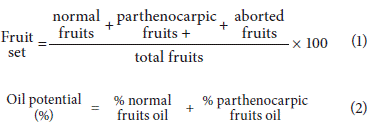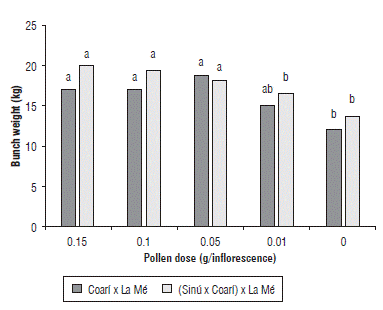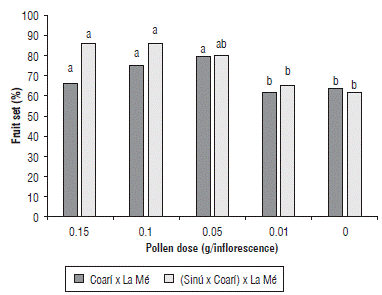Introduction
OxG hybrids are crossbred between American (Elaeis oleifera) and African (Elaeisguineensis) oil palms and began to be studied in 1970 because some crosses showed resistance to the disease "Bud Rot" (BR), with production over 30 t of bunches/ha/year (Genty and Ujueta, 2013). These hybrids are a valuable alternative for oil production because of their tolerance to pests and diseases, bunch production (25 to 30 t ha-1) and 18% oil extraction (Zambrano, 2004). In addition, their oil has high quality (55% oleic and 11% linoleic acids) and important contents of total vitamin E (tocotrienols 980 mg L-1 and tocopherols 100 mg L-1) (Mozzon et al., 2013; Mondragón and Pinilla, 2015) and carotenes (1375-1628 mg L-1) (Rocha et al., 2006; Rivera et al., 2013; Choo and Nesaretnam, 2014).
The hybrid bunches have more parthenocarpic fruits (PF) than normal fruits (NF). The color and oil percentage of red PF are similar to those of NF, but white PF do not have any oil (González et al., 2013). The advantage of hybrid red PF is that they develop and mature like NF, but contain more oil because of their higher proportion of mesocarp, which can reach 98% of the fruit (Bastidas et al., 2007; Preciado et al., 2011a). In addition, the contribution of red PF to the total bunch oil percentage is higher (20-50%) than that of NF (Preciado et al., 2011b).
Studies on the physiological development of OxG hybrid bunches have shown that the fruits have filling and maturation problems, probably because of asynchronous openings of the flowers or insufficient pollination (Hormaza et al., 2012; González et al., 2013). In addition, female inflorescences are covered by fibrous spathes that hinder the entry of pollen and pollinators, which translates into a considerable percentage of bunches with aborted fruits (AF) and lower oil potential per bunch (OP) (Zambrano, 2004). For this reason, hybrid plantations employ the practice of assisted pollination, applying E. guineensis palm pollen to the inflorescences of hybrid palms to guarantee that female flowers in anthesis receive enough pollen for the development of fruits and reach a reasonable production of bunches (Prada and Romero, 2012; Barcelos et al., 2015). The pollen quality depends on the genetic origin, viability, germination capacity and pollen tube growth (Godefroid et al., 2010; Shivanna and Tandon, 2014) and is a fundamental requirement in assisted pollination in order to achieve complete fruit set of the bunch.
Haniff and Rosland (2002), in a study on assisted pollination in 12-year-old Tenera palms in Malaysia, evaluated increasing pollen doses (0.0001, 0.001, 0.01, 0.1, 1.0 and 5.0 g/inflorescence) and found that the dose of 0.01 g/inflorescence significantly increased the bunch weight (BW). Since assisted pollination is a very costly agronomic practice for plantations, it is necessary to generate specific management programs for hybrid materials that define the optimal dose of viable pollen in order to guarantee the formation of fruits and reduce costs. The objective of this study was to evaluate the influence of several doses of pollen on fruit development and potential oil production in OxG hybrids.
Materials and methods
Location and plant material
This study was conducted on the OxG hybrids Coarí x La Mé (CxLM) and (Sinú x Coarí) x La Mé (SxCxLM) in an Indupalma experimental field in San Alberto, Cesar, Colombia (10°20' N, 73°11' W, at 125 m a.s.l., maximum temperature 34°C, minimum temperature 22°C, 72% relative humidity, annual precipitation 2,497 mm/year, annual evaporation 1,208 mm and 2,130 h of sunshine/year).
Experimental design
The response of the two hybrids to four 76% germination pollen doses (0.15, 0.10, 0.05, and 0.01 g/inflorescence) and natural pollination as a control was evaluated in a completely randomized design (CRD) with a 2x5 factorial arrangement (factor 1: hybrids and factor 2: pollen doses), four replicates and nine inflorescences/replicate.
Pollination
The pollen used in this experiment was collected in August, 2013 from selected African Tenera palms, in which the male inflorescences were cut in anthesis (stage 607) according to the scale proposed by Hormaza et al. (2012) and taken to the Indupalma Seed Laboratory, where the finger-like spines were separated on Kraft paper and dried in a forced convection oven for 12 h at 39°C until 6% humidity; then, they were shaken carefully to release the pollen from the anthers, which was screened with No. 100 and 200 sieves to remove impurities, vacuum packed and stored at -4°C. The pollen quality used in the treatments was determined with the germination test described by Turner and Gilbanks (1974), which counts the percentage of pollen grains that emit a pollen tube; only pollen with 76% germination was used.
The female inflorescences were selected in phenological stage 602 or preanthesis II (Hormaza et al., 2012) (Fig. 1A); then, the spathes were removed (Fig. 1B) and covered with insulation bags fitted to the base with an elastic band to avoid contamination from surrounding natural pollen (Fig. 1C). The pollination treatments were carried out when the inflorescences reached the anthesis stage (phenological stage 607), that is, when more than 80% of the flowers had cream-colored receptive stigmas (Hormaza et al., 2011) (Fig. 1 D). Before the application of the pollen, it was verified that no live insects were inside the bagged female inflorescences to avoid any contamination from foreign pollen; next, the pollen, mixed with inert talc as a transport agent (1:9 ratio), was generously sprinkled through a small hole made with a punch in the plastic window of the isolation bags (Fig. 1E).
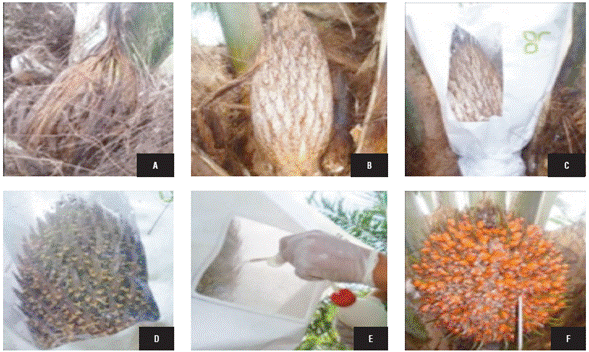
FIGURE 1 Development stages of the female inflorescences (Hormaza et al., 2012). A) pre-anthesis II (phenological stage 602), B) isolated inflorescence, C) enfolded inflorescence, D) anthesis (phenological stage 607), E) pollination, F) mature bunch.
The mature bunches were harvested 154 d after pollination, when they naturally detached one to five fruits per bunch (Fig. 1F). The physical analysis of the bunches was done with the methodology described by García and Yáñez (2000) to determine the BW, weight of NF and PF, fruit set coefficient (1) and bunch oil potential (OP) (2) with a sub-sample of 10 g of dry mesocarp using the Soxhlet method, with hexane as the solvent.
Results and discussion
Bunch weight
Bunch weight (BW) is the sum of the combined weight of spikelets with their individual fruits and the weight of the peduncle or rachis (Mohd, 2000). Figure 2 shows that the higher doses of pollen (0.15, 0.05) produced bunches with a higher weight than the lower doses and natural pollination. Similar trials have also reported a significant increase in BW with doses higher than 0.01 g/inflorescence (Haniff and Rosland, 2002). The natural pollination of the hybrids was very low because of the low emission of male inflorescences that produced a small amount of pollen (5 to 10 g/ inflorescence) with low viability (2 to 25%) (Hormaza et al., 2012), which was unattractive to the pollinating insect Elaeidobius kamerunicus (Tan, 1985).
Fruit set
In the two hybrids, the higher pollen doses provided the largest fruit set, with significant statistical differences when compared to the lowest dose (0.01 g) and the natural pollination control (Fig. 3). The expected result took into account the fact that fruit set depends on the proportion of NF and PF in bunches and, consequently, is directly related to BW, as effectively observed in this study with the higher BW obtained with the high doses. These results agree with those of Haniff and Roslan (2002), who observed a significant increase in BW and fruit set with a pollen dose that was increased from 0.0001 to 0.01 g when using assisted pollination on E. guineensis palms.
Fruits/bunch and oil potential
Table 2 shows that there were no significant statistical differences between the hybrids and pollen doses for the NF, PF and AF percentages. However, the tendency for a higher percentage of NF rather than PF was observed with the higher pollen doses. This is a logical consequence of the amount of pollen grains that reach the inflorescence in anthesis, which favors the formation of NF fruits. It has been proven that the assisted pollination of inflorescences in E. guineensis palms and OxG hybrids substantially increases the proportion of NF/bunch (Tam, 1981; Rosero and Santacruz, 2014, 2017).
TABLE 2 Effect of pollen dose (g/inflorescence) on the normal fruits (NF), parthenocarpic fruits (PF), aborted fruits (AF), and oil potential (OP) in the bunches of the two OxG hybrids.
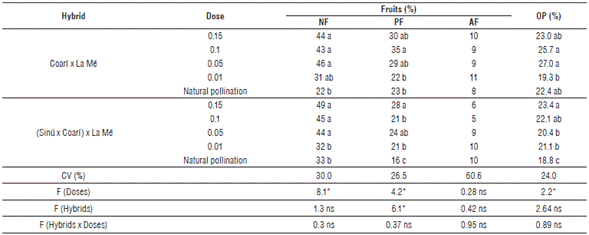
*F test significant (P<0.05). ns F test not significant (P<0.05)
The higher proportion of PF in hybrid bunches is attributed to the maternal inheritance of the palm E. oleifera, characterized by numerous PF that can form up to 90% of the total bunch (Corley and Tinker, 2009), which occurs despite a high percentage of viable pollen (Hardon and Tan, 1969). Zambrano (2004) reported a proportion of between 22 and 49% PF/bunch in OxG hybrids, while Rosero and Santacruz (2017) reported between 44 and 56% PF/bunch. PF increases in bunches have a large impact on the bunch oil potential because the oil content is similar to or even higher than that of NF since the oil in PF pulp can reach up to 98% (Bastidas et al., 2011).
The low percentage of AF with all of the pollen doses indicates that the presence of these fruits was not due to the greater or lesser amount of pollen that reached the inflorescences in anthesis, but resulted from adverse factors during the initial development of the bunch fruits. Although the abortion of inflorescences and fruits usually occurs as a consequence of incorrect pollination, some extreme factors, such as water stress, fructification, pruning or shading, can increase it (Corley and Breure, 1992). The AF in the control treatment (natural pollination) were low in number because the experimental field was located between plots of E. guineensis, which, most likely, served as a source of pollen for the two hybrids. Hardon and Turner (1967) used natural pollination on E. guineensis palm plantations to demonstrate that the majority of pollen remains inside the canopy after emission by male inflorescences, a factor that may favor its transport to the palms.
The OP was higher with the higher doses of pollen (0.15 and 0.10), which showed higher percentages of NF and PF. This coincides with Corley and Tinker (2009), who stated that the variation that exists in OP depends on the proportion of NF and PF in the bunch, which contain oil. In fact, OP indicates the amount of oil that can be extracted per unit of fresh bunch (Moreno et al., 2017).













